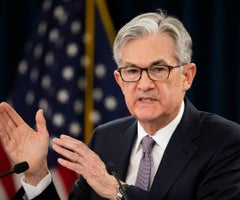MI SELECCIÓN DE NOTICIAS
Noticias personalizadas, de acuerdo a sus temas de interés

Chairman Jerome Powell has stressed that any changes the Fed makes would have to be backed up with action.
By considering changes to how it sets policy, the Fed’s stance could shift even if the economic outlook doesn’t
Fed Chairman Jerome Powell said Wednesday he is comfortable with the central bank’s current plan to hold interest rates steady, but he expressed frustration with inflation continuing to run below its 2% target.
This is important because the Fed could decide by the middle of the year to change its policy-setting approach. This raises three questions:
First, why is the Fed doing this now?
The Fed formally adopted the 2% inflation goal, a level it regards as consistent with healthy economic growth, in 2012. At the time, short-term rates were pinned near zero, but central bankers, economists and investors still expected them to return to more normal levels of 4% or so once the economic expansion matured.
Eight years later, interest rates are stuck at well below 4% for reasons that aren’t expected to change soon, such as demographics and global forces that have pushed down inflation. The Fed left its benchmark federal-funds rate unchanged Wednesday in a range between 1.5% and 1.75%. This leaves the Fed little room to cut rates to counteract a downturn.
Meanwhile, the Fed has struggled to keep inflation at 2%. The misses have been relatively small, but officials are concerned because if the Fed can’t meet its target after a long time, consumers and businesses could expect even lower inflation. Such expectations can become self-fulfilling.
Low inflation holds down nominal interest rates, which could make it harder for the Fed to combat a recession-a point Mr. Powell repeated at his past two news conferences. “We’ve seen this dynamic play out in other economies around the world, and we’re determined to avoid it here in the United States,” he said Wednesday.
Second, how might the Fed’s new framework differ from its current one? Currently, the Fed says its target is symmetric, meaning it would be as uncomfortable with inflation running a little below 2% as it would be with inflation a little above 2%, and would work as hard either way to get it back to the goal. In this way, it is always aiming for 2%, and it doesn’t take into account previous deviations. Bygones are bygones.
Fed governor Lael Brainard, in a November speech, outlined one of the most plausible changes the Fed could make in which officials would shed this “bygones” approach and instead make up for past misses of the target. If inflation had averaged slightly below the target for five years, the Fed could spend the next few years seeking inflation slightly above the target, she said.
In other words, symmetry wouldn’t any longer apply just to Fed officials’ intentions. It would also apply to the outcomes. If the Fed misses 2%, it would want to miss on both sides of the target.
Mr. Powell on Wednesday cited a similar approach, but declined to endorse any of the options under consideration.
Third, what would that mean for setting interest rates?
Mr. Powell has stressed that any changes the Fed makes would have to be backed up with action. But how the Fed might change its policy to account for this new approach isn’t obvious.
Ms. Brainard suggested in her speech that the Fed could make clear that, whereas in the past it might have raised rates in response to rising inflation, it could now sit back and accept a so-called “opportunistic reflation” without lifting rates.
Most officials, for example, projected in December that if the economy grew steadily over the next few years, they could raise rates again by 2021 or 2022. Under the new approach, they could scale back or scrap planned increases even if the economy does grow as expected-demonstrating a greater tolerance for expected higher inflation.
Some economists believe the Fed would need to go further and cut rates to demonstrate its commitment to the new approach because it would be seeking inflation above 2%-something it seldom achieved during the current expansion.
The upshot is that understanding how the Fed will set rates this year could be a bit murkier than in past years. Normally, the Fed changes direction on rates when the economic outlook shifts. But sometimes it decides the same outlook merits a different path for interest rates, a change in the so-called reaction function. The framework review could result in such a change.
By Nick Timiraos
Paramount, la empresa matriz de CBS, MTV y otras propiedades de medios, está controlada por su presidenta, Shari Redstone
Con visita de musk a Pekín, Tesla supera obstáculos regulatorios y logra la aprobación de su sistema de asistencia al conductor para expandirse en ese país
El mandatario sostiene que la doctrina del país permite uso de armas nucleares para defender intereses de naciones amenazadas